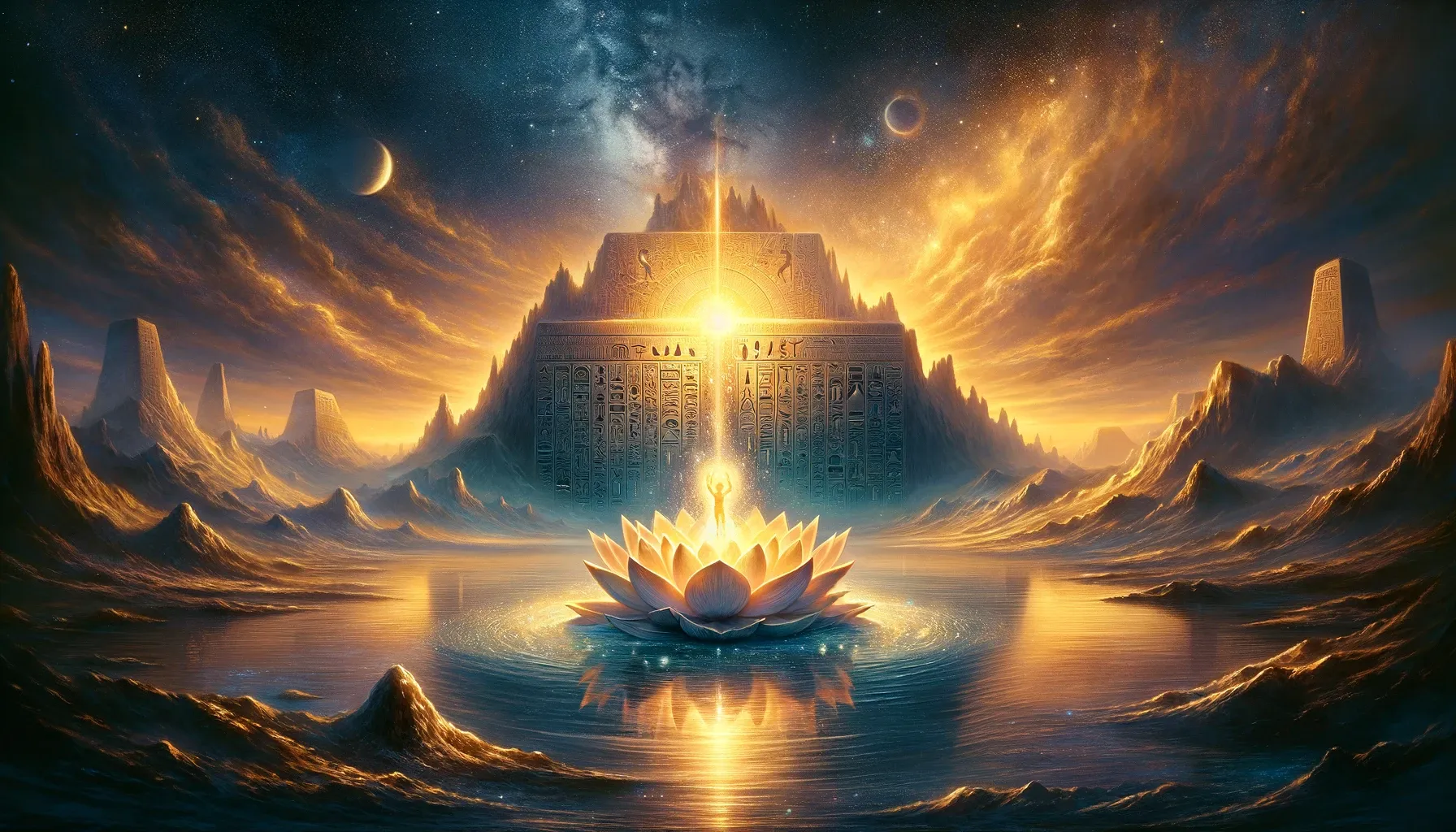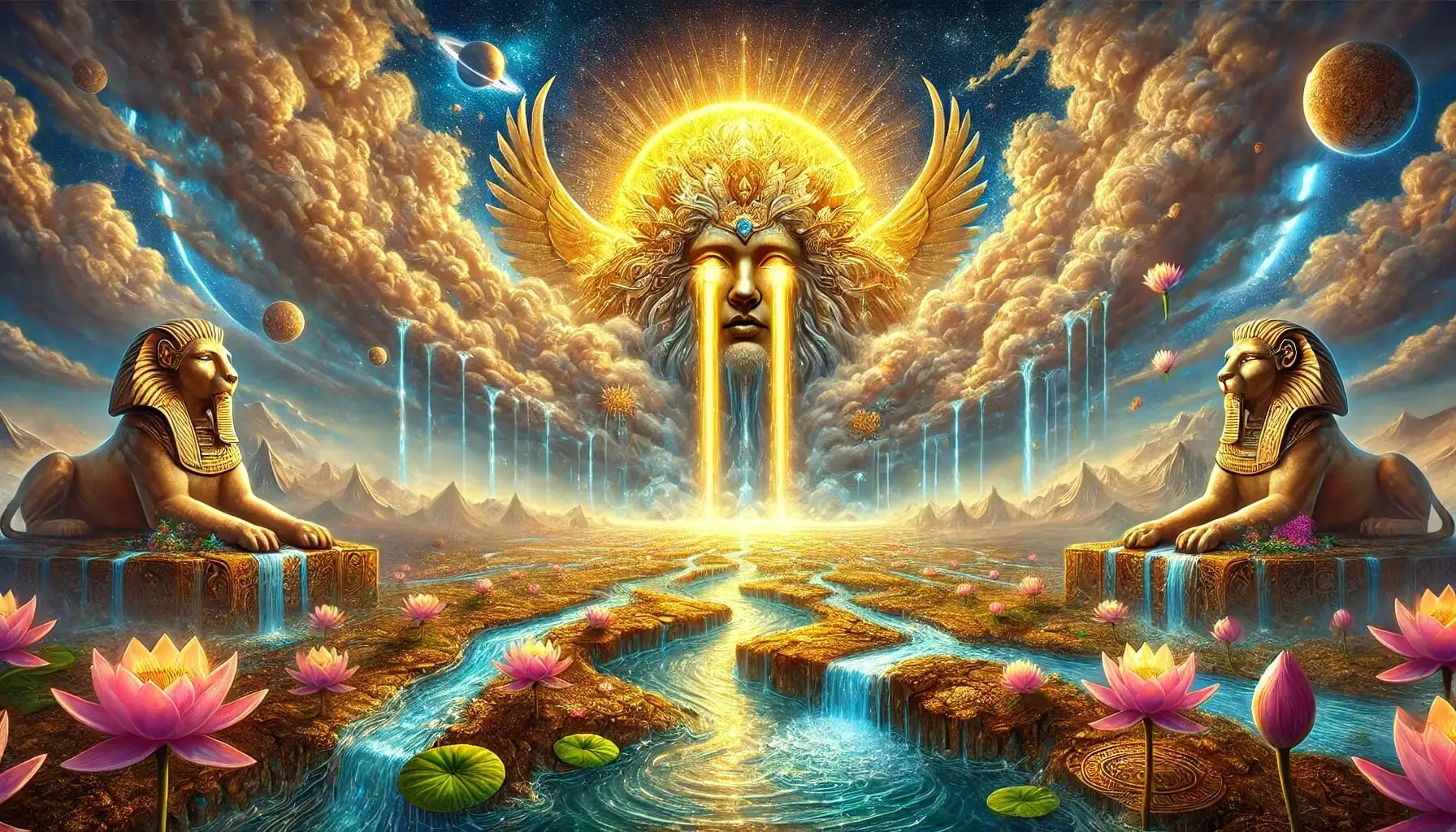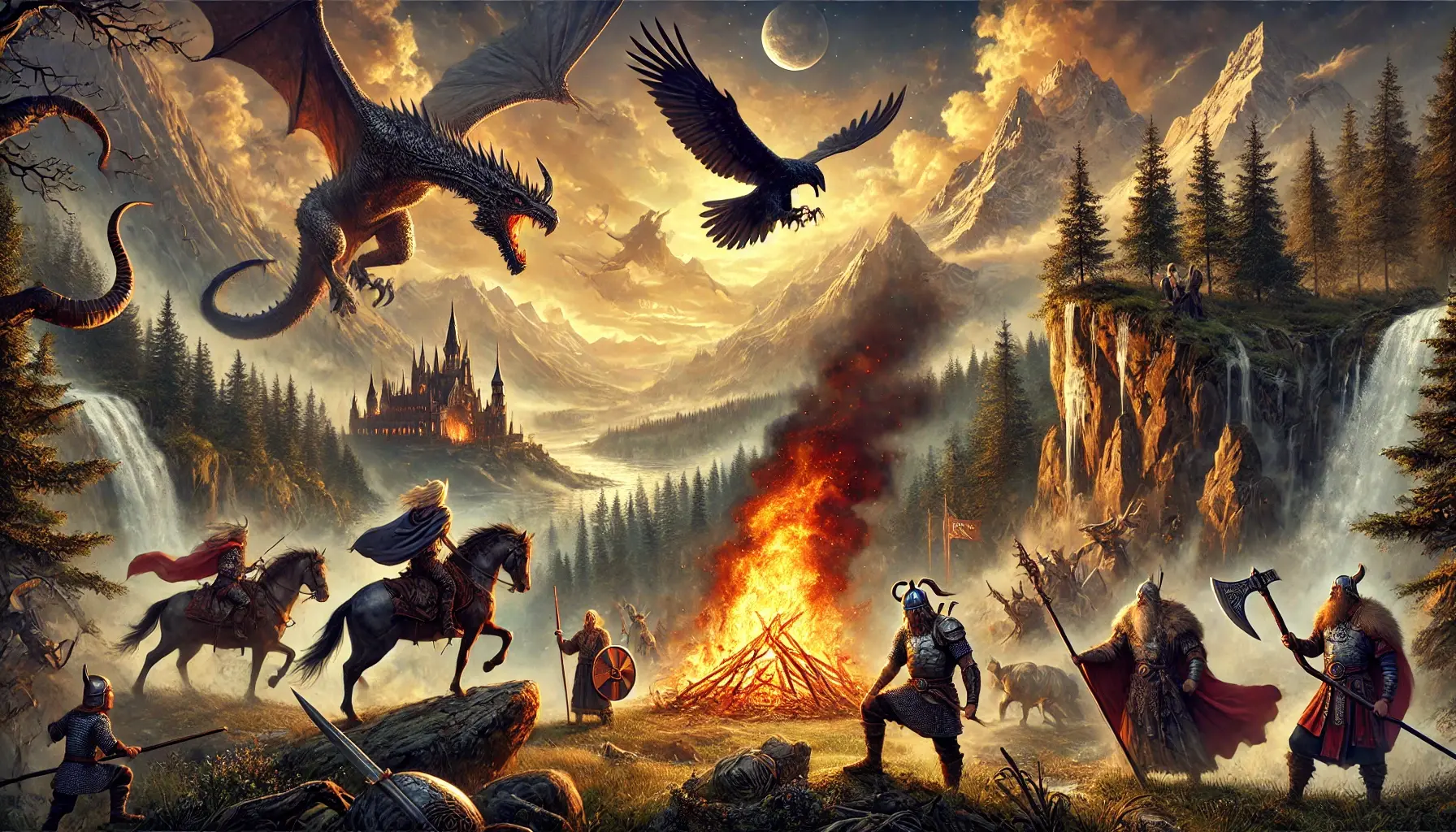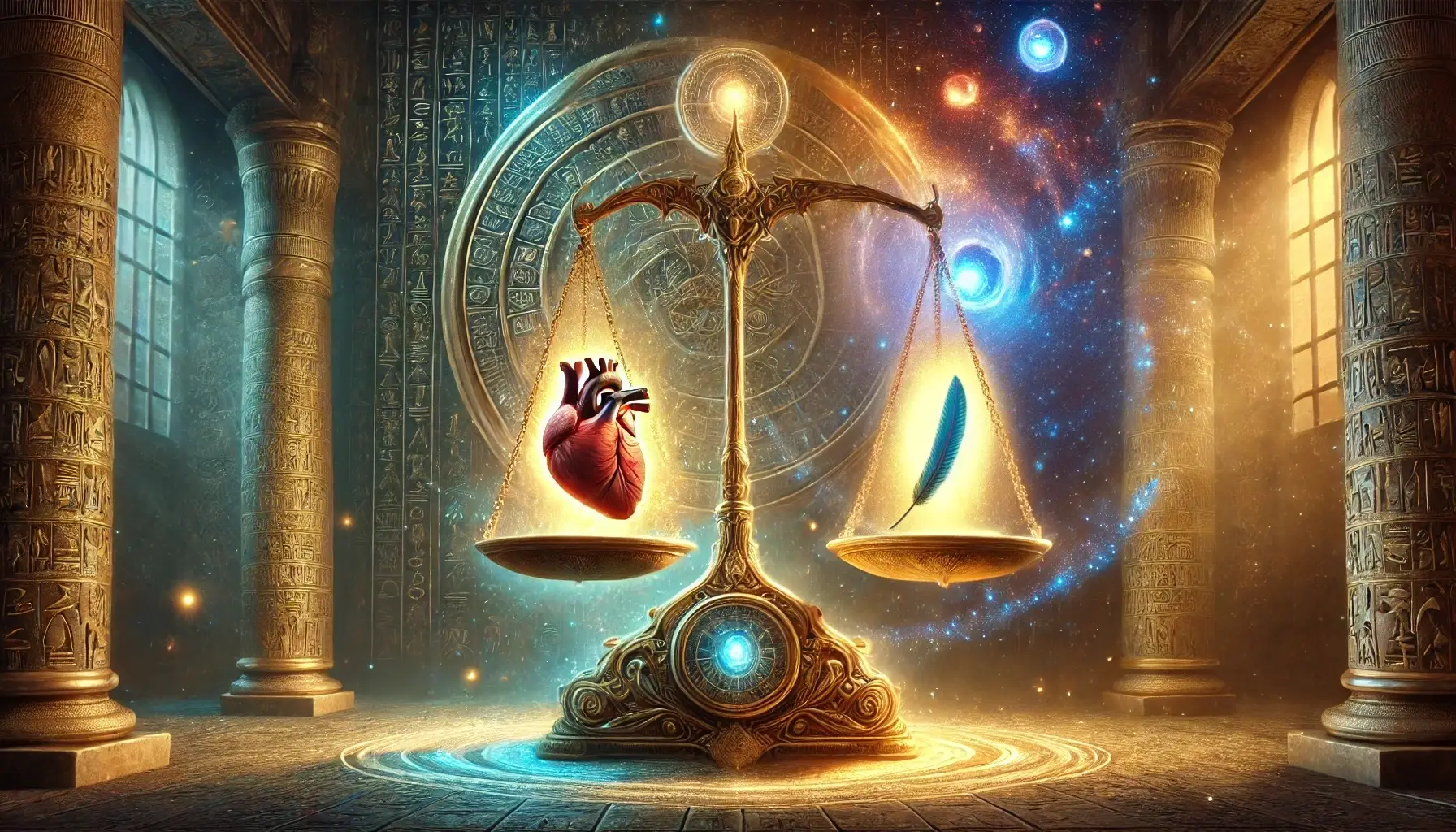The Birth of Primordial Chaos
Before the great land of Thebes bore its crown of temples and the Nile traced its fertile veins across the sands, there was only the boundless, formless void. This was the Nun, the eternal waters, dark and depthless, cradling the secrets of creation within their shifting currents. In the unmeasured vastness, no gods yet stirred, no sky or earth split the silence—only the infinite potential of the Nun, pregnant with possibility, awaited its first awakening.
From the Nun, a single mound rose, breaking the surface like a breath gasping into existence. This primordial hill, known as the Benben, glistened with the promise of life. It stood alone, radiant beneath a sun that had not yet risen, a stark reminder of what was yet to come. Atop this mound, the first god emerged—Atum, self-created and complete. Neither born of parents nor formed by any hand, Atum represented the singularity of existence. He drew forth his being from the void and stood as both creator and creation, the embodiment of the beginning.
Atum’s Act of Creation
In solitude, Atum contemplated the endless waters that surrounded him, their ceaseless motion mirroring his restless thoughts. To bring order to chaos, he summoned the dualities of existence, exhaling his breath to shape Shu, the god of air, and spitting forth Tefnut, the goddess of moisture. These twin forces, bound to their father by threads of divinity, marked the first division of unity, the first echoes of life rippling across the primordial expanse.
Atum watched his children disappear into the vastness of the Nun, and his heart quaked with loneliness. Fearing their loss, he sent his eye—a fragment of his own essence—to seek them out. The eye traveled through the chaotic waters, an orb of blazing intent cutting through shadow. When Shu and Tefnut returned, the god wept with joy, and where his tears fell upon the fertile earth of the Benben, they formed the first humans. Thus, mankind was born from divine grief, a reminder of the gods’ frailty as much as their power.
The Separation of Sky and Earth
Shu and Tefnut, united by their purpose, gave birth to Geb, the earth, and Nut, the sky. Their union was a tight embrace, a closeness that smothered creation beneath their weight. Atum, dismayed by their intimacy, ordered Shu to separate them, thrusting Nut upwards to form the heavens and pinning Geb below to become the foundation of life. The wrenching apart of Nut and Geb tore the cosmos into its first shape, and in their longing for each other, the seasons were born—the earth’s cycles reflecting the eternal yearning of their sundered bond.
From this division, the world began to take its form. Nut arched her starry body over Geb, whose fertile surface sprouted rivers and mountains, a tapestry of life spread across his skin. Yet their separation was not without consequence. The gods of strife and vitality—Osiris, Isis, Set, and Nephthys—were born of their union before the split, each destined to play a role in the tumultuous saga of divine and mortal affairs.
The Founding of Thebes
Thebes, known in its earliest days as Waset, rose as a city blessed by the gods yet shaped by mortal hands. It was said that the first pharaohs, inspired by divine visions, chose this land for its proximity to the celestial Nile, where the gods themselves had once tread. In its infancy, Thebes was not the sprawling city of obelisks and sanctuaries it would become, but a sacred place where the spirits of the first gods were believed to dwell. Its foundation mirrored the creation of the cosmos—an act of imposing order upon chaos, carving meaning into the unknowable.
The priests of Thebes spoke of Amun, a hidden god who emerged to take his place alongside Atum. Amun was the unseen wind, the silent force that animated creation and moved the hearts of mortals. His rise marked the city’s ascent as a spiritual heart of Egypt, where kings and commoners alike sought his favor, their prayers rising like incense to the heavens.
The Struggle Between Order and Chaos
As the gods’ creation flourished, so too did discord. Set, the storm-bringer, harbored jealousy for his brother Osiris, whose reign over the earth was marked by abundance and justice. Set’s treachery shattered this fragile harmony when he slew Osiris, dismembering his body and scattering the pieces across Egypt. Isis, Osiris’ faithful wife, embarked on a perilous quest to gather her husband’s remains, her tears swelling the Nile and renewing the land’s fertility. With the aid of Anubis, the god of embalming, Isis restored Osiris to life, though not to the world of the living. He became the ruler of the Duat, the underworld, overseeing the judgment of souls.
The struggle between Set and the forces of order did not end with Osiris’ death. Horus, the falcon-headed son of Osiris and Isis, grew to challenge his uncle’s claim to power. Their battle spanned heavens and earth, a cosmic contest mirrored in the mortal realm. In time, Horus triumphed, ascending as the rightful king and restoring Ma’at—the principle of cosmic balance—to the world.
The Eternal Cycle
The creation myth of Thebes, like the Nile’s floodwaters, flows in cycles. It speaks of beginnings and endings, of gods who weep and mortals who toil beneath their gaze. The tale of Atum’s first act echoes in every sunrise, as Ra, the solar god, sails across the sky, vanquishing the serpent Apep to ensure light’s return. It lives in the shifting sands of Geb and the endless stretch of Nut’s starry form, a reminder of the unity that underpins the fragmented world.
The Last Image
As the sun dipped below the horizon, the temple of Karnak cast long shadows over the city of Thebes. A lone priest stood atop its sacred walls, his gaze fixed on the swelling Nile. He whispered the ancient prayers of Atum, his voice a thread weaving the past into the present. Below him, the river glimmered like liquid gold, its currents carrying the weight of history and the promise of renewal.
In the twilight, the waters seemed to part, revealing a flicker of the primordial Benben beneath the waves. For an instant, the priest thought he saw Atum standing there, his solitary figure mirrored in the river’s depths. The god’s hand reached toward the sky, as if to summon creation anew. Then the vision dissolved, leaving only ripples in the water and the priest’s breath hanging in the cool evening air.
He descended the temple steps, his sandals brushing against stone etched with the prayers of countless generations. As he walked, he felt the weight of time settle upon him, a reminder that all things—gods, cities, men—are but fleeting reflections of the eternal. Yet, in their transience, they carry the spark of creation, the promise of beginnings yet to come.
The stars emerged one by one, dotting Nut’s darkened canopy. The priest paused and looked up, his heart swelling with reverence and wonder. Somewhere in the heavens, the gods continued their eternal dance, their stories written in the constellations. And in the stillness of the night, Thebes breathed, its pulse steady and strong, a testament to the enduring rhythm of creation.



